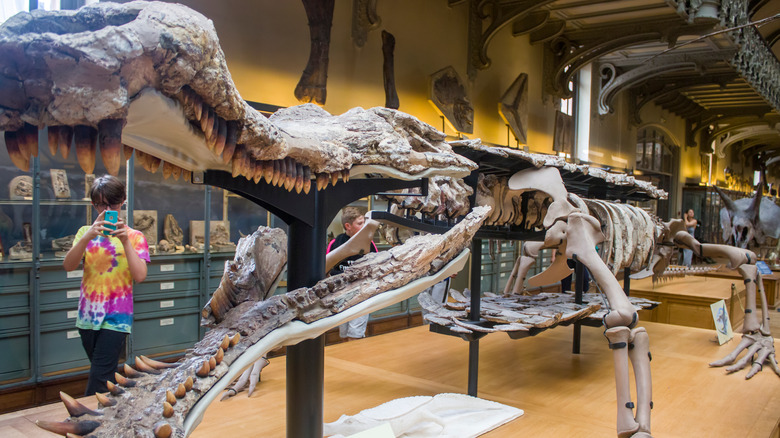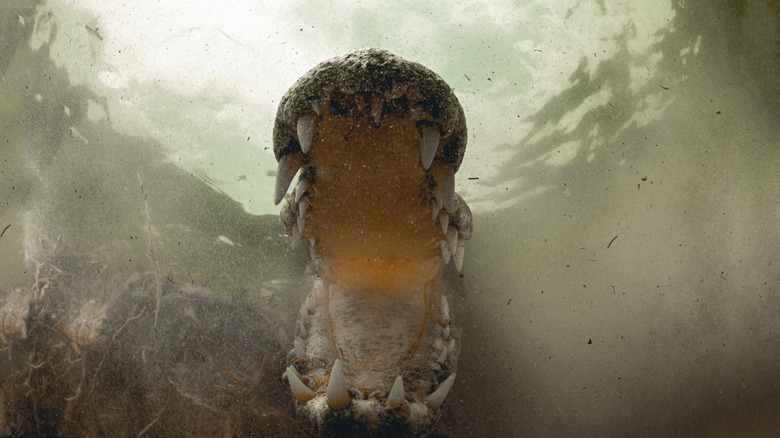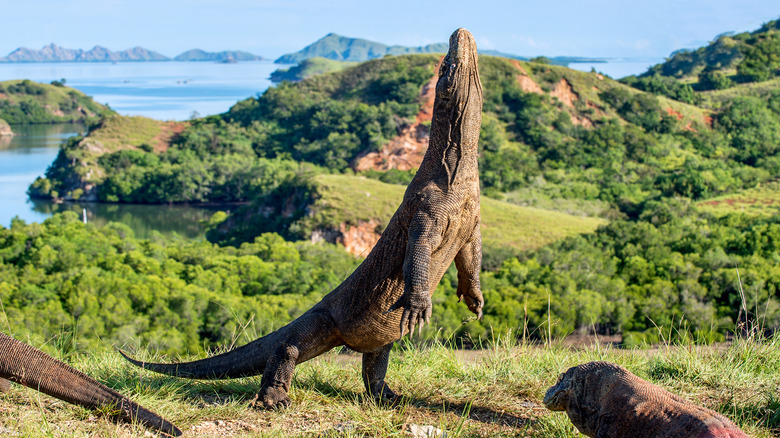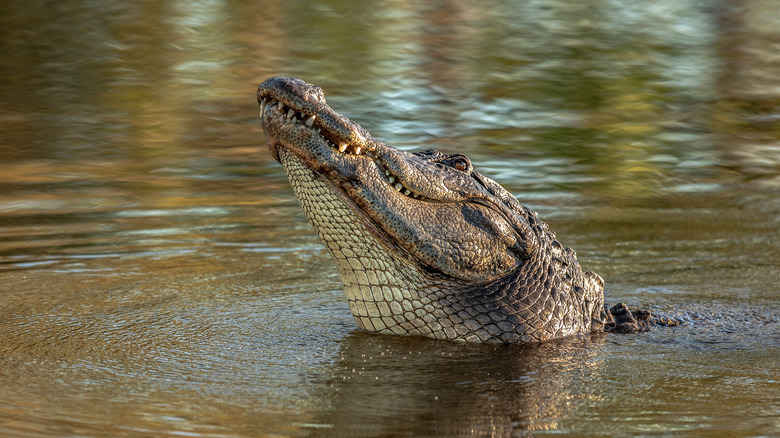The Sahara Used To Be Home To Galloping Crocodiles
The Earth was a vastly different place 100 million years ago. Dinosaurs soared and screeched overhead while lush trees swayed from one corner to the next. The seas brimmed with the notorious Opabinia, a five-eyed ocean-dwelling creature sporting a clawed trunk on the front of its face (via Smithsonian Magazine). Flying high through the skies were massive dragonflies with wingspans two feet across. And on land, carnivorous creatures ruled as they roared, from the Andrewsarchus to the Tyrannosaurus Rex, flexing their massive, capable jawlines. But this is only the beginning.
According to The Guardian, in 2009, fossil hunters excavating the Saharan Desert uncovered the skeletal remains of not one, not two, but three baffling beasts who they believe were once equally terrifying by land and sea. It appears that these ancient galloping crocodiles with jagged tusks and snarling teeth balked in the face of danger and devoured dinosaurs for breakfast.
Kaprosuchus saharicus
Discover Magazine reports that Kaprosuchus saharicus was one of the three new galloping crocodile species discovered by Paleontologist Paul Sereno in the Saharan section of northern Africa. Clearly the most ferocious of the three, Kaprosuchus saharicus is believed to have used its three sets of sawtooth fangs in conjunction with its armored snout to rip land and sea-dwelling dinosaurs limb from limb, surviving on a carnivorous diet consisting mostly of dinos and other land-dwelling mammals.
It isn't just the diet and the fangs that make Kaprosuchus so fascinating. According to the Guardian, all three new species possess a rather unique physical attribute in the form of protruding legs made especially for galloping. While crocodiles of today can still gallop for short stints, they are mostly seen moving on land with their bellies low to the ground. Yet a paper published in the journal Scientific Reports found that "modern crocodiles employ almost the full range of quadrupedal footfall patterns ("gaits") used by mammals; including asymmetrical gaits such as galloping and bounding," which the authors chalk up to residual abilities retained in the evolutionary process.
It appears some of their ancestors, like the Kaprosuchus saharicus, had stealthy legs that allowed them to bound through land and sea with ease. A 21-foot mammoth of a creature, the existence of this crocodile paints a formidable portrait of life in the Cretaceous period.
Araripesuchus rattoide
Standing at approximately 3.2 feet in stature, the Araripesuchus rattoide was comparatively dwarfed but equally equipped with legs for scouring the land (via IFL Science). Lovingly referred to as the "rat croc" by discoverer Paul Sereno, this leggy crocodile of yore is believed to have been an herbivore surviving on plants and grub (per Paul Sereno).
In addition to a stealthy set of legs, the Araripesuchus rattoide is easily identifiable thanks to its telltale set of buckteeth which make excellent digging equipment, all the better to feast on ancient vegetation. It's important to note that while all three ancient crocodile skeletons were uncovered in the same region of Africa between Niger and Morocco, experts suspect they each possessed their own unique diets and personalities, an aftereffect of having a divided ecosystem (via The Guardian). Whether their preference was botanical or carnivorous, their ability to stand upright is what stands out most.
Laganosuchus thaumastos
Of the three, the Laganosuchus thaumastos is the ancient crocodile species that most resembles the crocs we see today. The Guardian reports that this fish-eater was approximately 20 feet in length, with a gaping mouth it used to capture fish passing through the murky ancient seas. The semi-aquatic ancient croc used its tail as a kind of paddle to cut through the waves. It too, was capable of hurdling through the Saharan sands on upright legs but preferred to hunt by sea.
Laganosuchus thaumastos was nicknamed the "pancake croc" in honor of its massive flat-shaped head. All three 2009 discoveries were made in the same vicinity where Paleontologist Paul Sereno discovered Sarcosuchus imperator, a gigantic 40-foot, eight-ton ancient crocodile who was also believed to eat dinosaurs for breakfast (via Paul Sereno).
In a quote from a National Geographic interview later published online by The Guardian, the famed paleontologist and croc enthusiast Paul Sereno stated, "These species open a window on a croc world completely foreign to what was living on northern continents."



